2022 年宁夏高考英语真题及答案
注意事项:
1. 答卷前,考生务必将自己的姓名、准考证号填写在答题卡上。
2. 回答选择题时,选出每小题答案后,用铅笔把答题卡上对应题目的答案标号涂黑。如需
改动,用橡皮擦干净后,再选涂其他答案标号。回答非选择题时,将答案写在答题卡上,
写在本试卷上无效。
3. 考试结束后,将本试卷和答题卡一并交回。
第一部分听力(共两节,满分 30 分)
做题时,先将答案标在试卷上。录音内容结束后,你将有两分钟的时间将试卷上的答案转
涂到答题卡上。
第一节(共 5 小题;每小题 1.5 分,满分 7.5 分)
听下面 5 段对话。每段对话后有一个小题,从题中所给的 A、B、C 三个选项中选出最佳选
项。听完每段对话后,你都有 10 秒钟的时间来回答有关小题和阅读下一小题。每段对话仅
读一遍。
例:How much is the shirt?
A. £19.15.
B. £9.18.
C. £9.15.
答案是 C。
1. What does the man want to do?
A. Have breakfast.
B. Take a walk.
C. Call his office.
2. What was George doing last night?
A. Having a meeting.
3. Why does the man suggest going to the park?
B. Flying home.
C. Working on a project.
A. It’s big.
B. It’s quiet.
C. It’s new.
4. How does the woman sound?
A. Annoyed.
B. Pleased.
C. Puzzled.
5. Where is the man’s table?
A. Near the door.
B. By the window.
C. In the corner.
第二节(共 15 小题;每小题 1.5 分,满分 22.5 分)
听下面 5 段对话或独白。每段对话或独白后有几个小题,从题中所给的 A、B、C 三个选项
中选出最佳选项。听每段对话或独白前,你将有时间阅读各个小题,每小题 5 秒钟;听完后,
各小题将给出 5 秒钟的作答时间。每段对话或独白读两遍。
听第 6 段材料,回答第 6、7 题。
6. What are the speakers going to do tonight?
A. Eat out.
B. Go shopping.
C. Do sports.
7. What is the probable relationship between the speakers?
A. Boss and secretary.
B. Hostess and guest.
C. Husband and wife.
�
听第 7 段材料,回答第 8、9 题。
8. Why does the woman think July is the best time to move?
A. Their business is slow.
B. The weather is favorable.
C. It’s easy to
hire people.
9. How will they handle the moving?
A. Finish it all at once.
B. Have the sales section go first.
C. Do one
department at a time.
听第 8 段材料,回答第 10 至 12 题。
10. What did Peter learn from his grandfather?
A. How to appreciate art works.
B. How to deal with artists.
C. How to
run a museum.
11. What did Peter do in Chicago?
A. He studied at a college.
B. He served in the army.
C. He worked in a
gallery.
12. Whose works did Peter like best?
A. Rembrandt’s.
B. Botticelli’s.
C. Rubens’.
听第 9 段材料,回答第 13 至 16 题。
13. Where does the conversation take place?
A. At a library.
B. In a law firm.
C. On a train.
14. By what time did John plan to finish his term paper?
A. March.
B. August.
C. October.
15. Why did John quit his part-time job?
A. He had to catch up with his study.
He got tired of it.
B. He was offered a better one.
C.
16. What is Susan’s attitude to John’s problem?
A. Carefree.
B. Understanding.
C. Forgiving.
听第 10 段材料,回答第 17 至 20 题。
17. What did the speaker do before the year 2012?
A. A fitness coach.
B. A chess player.
C. A marathon runner.
18. Why was the 2016 Olympics important for the speaker?
A. He was motivated by Bolt.
B. He broke a world record.
C. He won fifth
place.
19. Which is the hardest for the speaker?
A. Getting over an injury.
B. Doing strength training.
C. Representing
Botswana.
20. What is the speaker mainly talking about?
�
A. His plan to go for the gold.
B. His experience on the track.
C. His love for his home country.
第二部分 阅读理解(共两节,满分 40 分)
第一节(共 15 小题;每小题 2 分,满分 30 分)
阅读下列短文,从每题所给的 A、B、C 和 D 四个选项中,选出最佳选项。
A
Henry Raeburn (1756-1823)
The Exhibition
This exhibition of some sixty masterpieces celebrating the life and work of
Scotland’s best loved painter, Sir Henry Raeburn, comes to London. Selected from
collections throughout the world, it is the first major exhibition of his work to
be held in over forty years.
Lecture Series
Scottish National Portrait (肖像画) Gallery presents a series of lectures for
the general public. They are held in the Lecture Room. Admission to lectures is free.
An Introduction to Raeburn
Raeburn’s English Contemporaries
Sunday 26 Oct., 15.00
DUNCAN THOMSON
Thursday 30 Oct., 13.10
JUDY EGERTON
Characters and Characterisation in
Raeburn and Artist’s Training in the
Raeburn’s Portraits
18th Century
Thursday 6 Nov., 13.10
Thursday 13 Nov., 13.10
NICHOLAS PHILLIPSON
MARTIN POSTLE
Exhibition Times
Monday-Saturday 10.00-17.45
Sunday 12.00-17.45
Last admission to the exhibition: 17.15. There is no re-admission.
Closed: 24-26 December and 1 January.
Admission
£4. Children under 12 years accompanied by an adult are admitted free.
Schools and Colleges
�
A special low entrance charge of £2 per person is available to all in full-time
education, up to and including those at first degree level, in organised groups with
teachers.
1. What is the right time for attending Raeburn’s English Contemporaries?
A. Sun. 26 Oct.
B. Thurs. 30 Oct.
C. Thurs. 6 Nov.
D.
Thurs.13 Nov.
2. How much would a couple with two children under 12 pay for admission?
A. £4.
B. £8.
C. £12.
D. £16.
3. How can full-time students get group discounts?
A. They should go on Sunday mornings.
B. They should come from art
schools.
C. They must be led by teachers.
D. They must have ID cards with
them.
B
In 1916, two girls of wealthy families, best friends from Auburn, N. Y.—Dorothy
Woodruff and Rosamond Underwood—traveled to a settlement in the Rocky Mountains
to teach in a one-room schoolhouse. The girls had gone to Smith College. They wore
expensive clothes. So for them to move to Elkhead, Colo. to instruct the children
whose shoes were held together with string was a surprise. Their stay in Elkhead
is the subject of Nothing Daunted: The Unexpected Education of Two Society Girls
intheWest by Dorothy Wickenden, who is a magazine editor and Dorothy Woodruff’s
granddaughter.
Why did they go then? Well, they wanted to do something useful. Soon, however,
they realized what they had undertaken.
They moved in with a local family, the Harrisons, and, like them, had little
privacy, rare baths, and a blanket of snow on their quilt when they woke up in the
morning. Some mornings, Rosamond and Dorothy would arrive at the schoolhouse to find
the children weeping from the cold. In spring, the snow was replaced by mud over
ice.
�
In Wickenden’s book, she expanded on the history of the West and also on feminism,
which of course influenced the girls’ decision to go to Elkhead. A hair-raising
section concerns the building of the railroads, which entailed (牵涉) drilling
through the Rockies, often in blinding snowstorms. The book ends with Rosamond and
Dorothy’s return to Auburn.
Wickenden is a very good storyteller. The sweep of the land and the stoicism
(坚忍) of the people move her to some beautiful writing. Here is a picture of Dorothy
Woodruff, on her horse, looking down from a hill top: “When the sun slipped behind
the mountains, it shed a rosy glow all around them. Then a full moon rose. The snow
was marked only by small animals: foxes, coyotes, mice, and varying hares, which
turned white in the winter.”
4. Why did Dorothy and Rosamond go to the Rocky Mountains?
A. To teach in a school.
B. To study American history.
C. To write a book.
D. To do sightseeing.
5. What can we learn about the girls from paragraph 3?
A. They enjoyed much respect.
B. They had a room with a bathtub.
C. They lived with the local kids.
D. They suffered severe hardships.
6. Which part of Wickenden’s writing is hair-raising?
A. The extreme climate of Auburn.
B. The living conditions in
Elkhead.
C. The railroad building in the Rockies.
D. The natural beauty of the West.
7. What is the text?
A. A news report.
B. A book review.
C. A children’s story.D. A diary
entry.
C
Can a small group of drones(无人机)guarantee the safety and reliability of
railways and, at the same time, help railway operators save billions of euros each
year? That is the very likely future of applying today’s “eyes in the sky”
technology to making sure that the millions of kilometres of rail tracks and
infrastructure(基础设施)worldwide are safe for trains on a 24/7 basis.
�
Drones are already being used to examine high-tension electrical lines. They
could do precisely the same thing to inspect railway lines and other vital aspects
of rail infrastructure such as the correct position of railway tracks and switching
points. The more regularly they can be inspected, the more railway safety,
reliability and on-time performance will be improved. Costs would be cut and
operations would be more efficient(高效)across the board.
That includes huge savings in maintenance costs and better protection of railway
personnel safety. It is calculated that European railways alone spend approximately
20 billion euros a year on maintenance, including sending maintenance staff, often
at night, to inspect and repair the rail infrastructure. That can be dangerous work
that could be avoided with drones assisting the crews’ efforts.
By using the latest technologies, drones could also start providing higher-value
services for railways, detecting faults in the rail or switches, before they can
cause any safety problems. To perform these tasks, drones for rail don’t need to
be flying overhead. Engineers are now working on a new concept: the rail drones of
the future. They will be moving on the track ahead of the train, and programmed to
run autonomously. Very small drones with advanced sensors and AI and travelling ahead
of the train could guide it like a co-pilot. With their ability to see ahead, they
could signal any problem, so that fast-moving trains would be able to react in time.
8. What makes the application of drones to rail lines possible?
A. The use of drones in checking on power lines.
B. Drones’ ability to work
at high altitudes.
C. The reduction of cost in designing drones. D. Drones’ reliable performance
in remote areas.
9. What does “maintenance” underlined in paragraph 3 refer to?
A. Personnel safety.
B. Assistance from drones.
C. Inspection and repair.
D. Construction of infrastructure.
10. What function is expected of the rail drones?
A. To provide early warning.
B. To make trains run
automatically.
�
C. To earn profits for the crews.
D. To accelerate transportation.
11. Which is the most suitable title for the text?
A. What Faults Can Be Detected with Drones
B. How Production of Drones Can Be Expanded
C. What Difficulty Drone Development Will Face
D. How Drones Will Change the Future of Railways
D
The Government's sugar tax on soft drinks has brought in half as much money as
Ministers first predicted it would generate, the first official data on the policy
has shown.
First announced in April, 2016, the tax which applies to soft drinks containing
more than 5g of sugar per 100ml, was introduced to help reduce childhood obesity
(肥胖). It is believed that today's children and teenagers are consuming three
times the recommended level of sugar, putting them at a higher risk of the disease.
Initially the sugar tax was expected to make £520m a year for the Treasury.
However, data of the first six months showed it would make less than half this amount.
At present it is expected to generate £240m for the year ending in April 2019, which
will go to school sports.
It comes after more than half of soft drinks sold in shops have had their sugar
levels cut by manufacturers(制造商)so they can avoid paying the tax. Drinks now
contain 45 million fewer kilos of sugar as a result of manufacturers' efforts to
avoid the charge, according to Treasury figures. Since April drinks companies have
been forced to pay between 18p and 24p for every litre of sugary drink they produce
or import, depending on the sugar content.
However, some high sugar brands, like Classic Coca Cola, have accepted the sugar
tax and are refusing to change for fear of upsetting consumers. Fruit juices,
milk-based drinks and most alcoholic drinks are free of the tax, as are small
companies manufacturing fewer than 1m litres per year.
Today's figures, according to one government official, show the positive
influence the sugar tax is having by raising millions of pounds for sports facilities
�
(设施)and healthier eating in schools. Helping the next generation to have a healthy
and active childhood is of great importance, and the industry is playing its part.
12. Why was the sugar tax introduced?
A. To collect money for schools.
B. To improve the quality of
drinks.
C. To protect children’s health.
D. To encourage research in
education.
13. How did some drinks companies respond to the sugar tax?
A. They turned to overseas markets.
B. They raised the prices of their
products.
C. They cut down on their production.
D. They reduced their products’
sugar content.
14. From which of the following is the sugar tax collected?
A. Most alcoholic drinks.
B. Milk-based drinks.
C. Fruit
juices.
D. Classic Coke.
15. What can be inferred about the adoption of the sugar tax policy?
A. It is a short-sighted decision.
B. It is a success story.
C. It benefits manufacturers.
D. It upsets customers.
第二节(共 5 小题;每小题 2 分,满分 10 分)
根据短文内容,从短文后的选项中选出能填入空白处的最佳选项。选项中有两项为多余选
项。
Friendship needs care and attention to keep it in good health. Here are five
ways to sustain (保持) long-distance friendships.
·Set a regular date
Long-lasting friendships share the characteristic that both sides equally
contact (联系) and share with one another. With busy schedules, squeezing in phone
calls can be a challenge. ___16___.
·More isn’t always merrier
Make sure you have communicated with your friend about how frequently each of
you wants to be contacted and what method works best for you both. ___17___. There
�
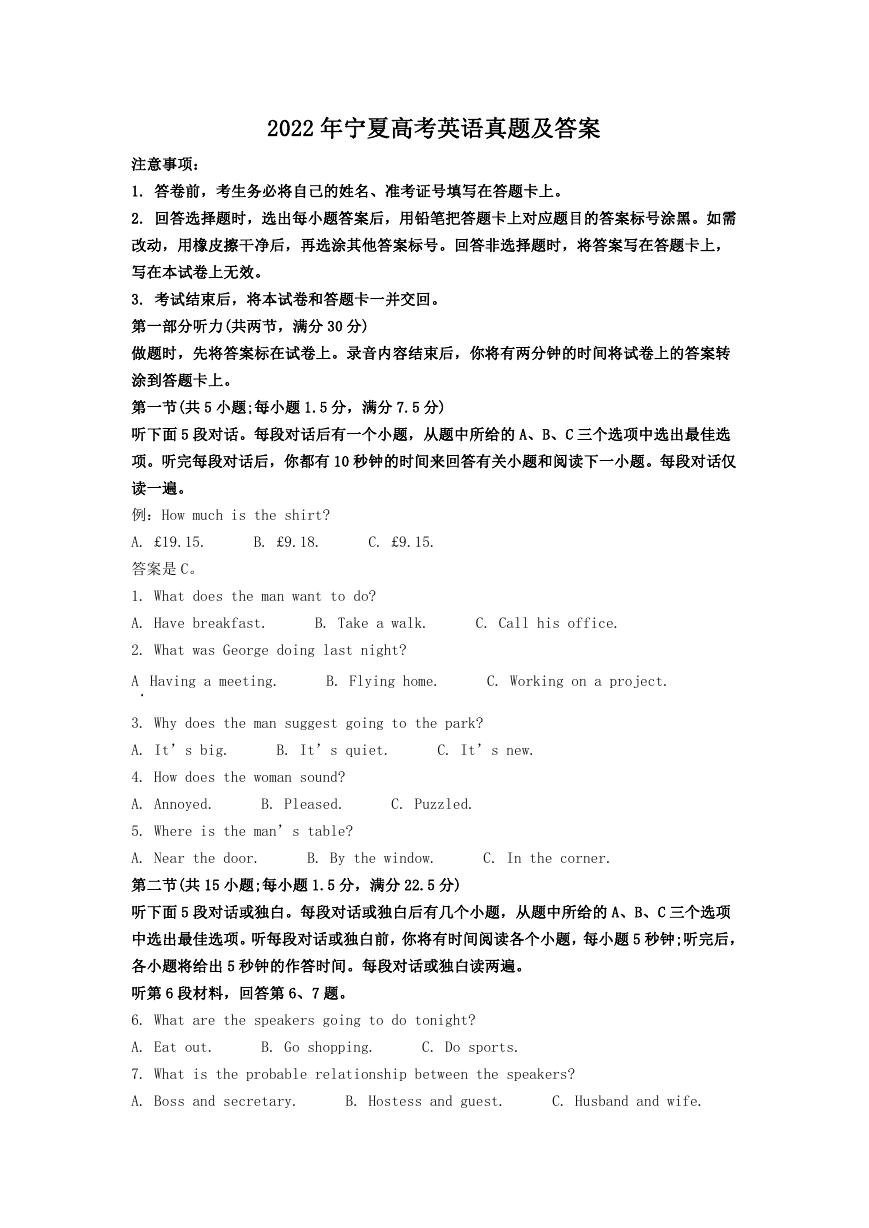
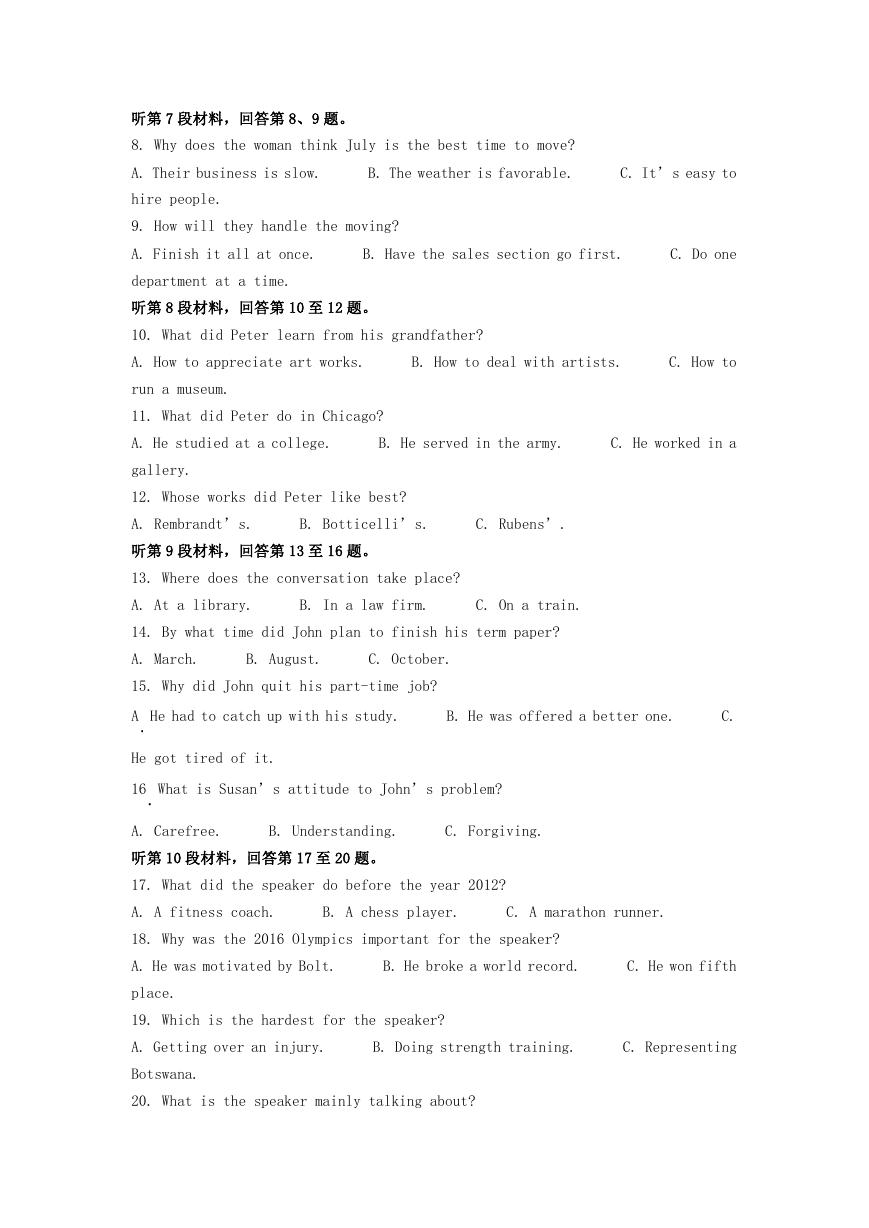
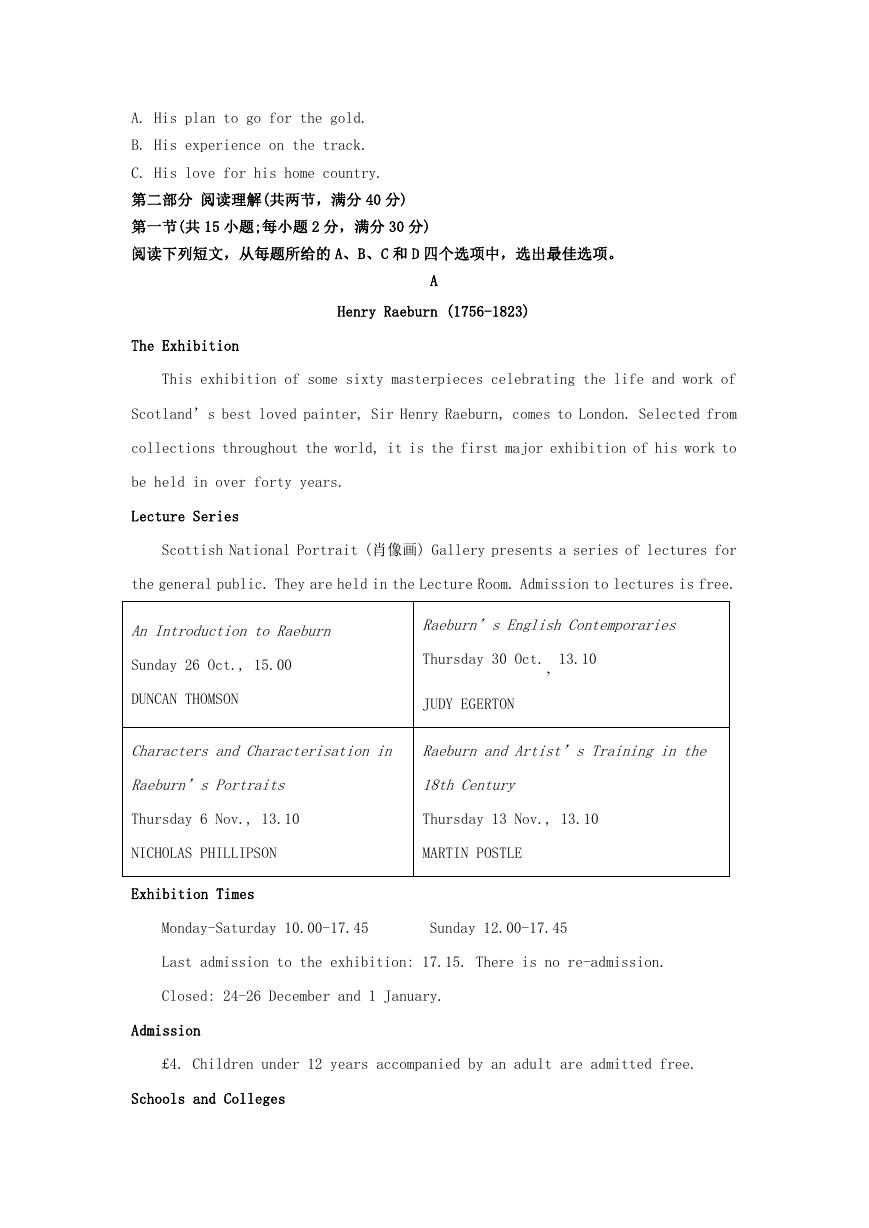
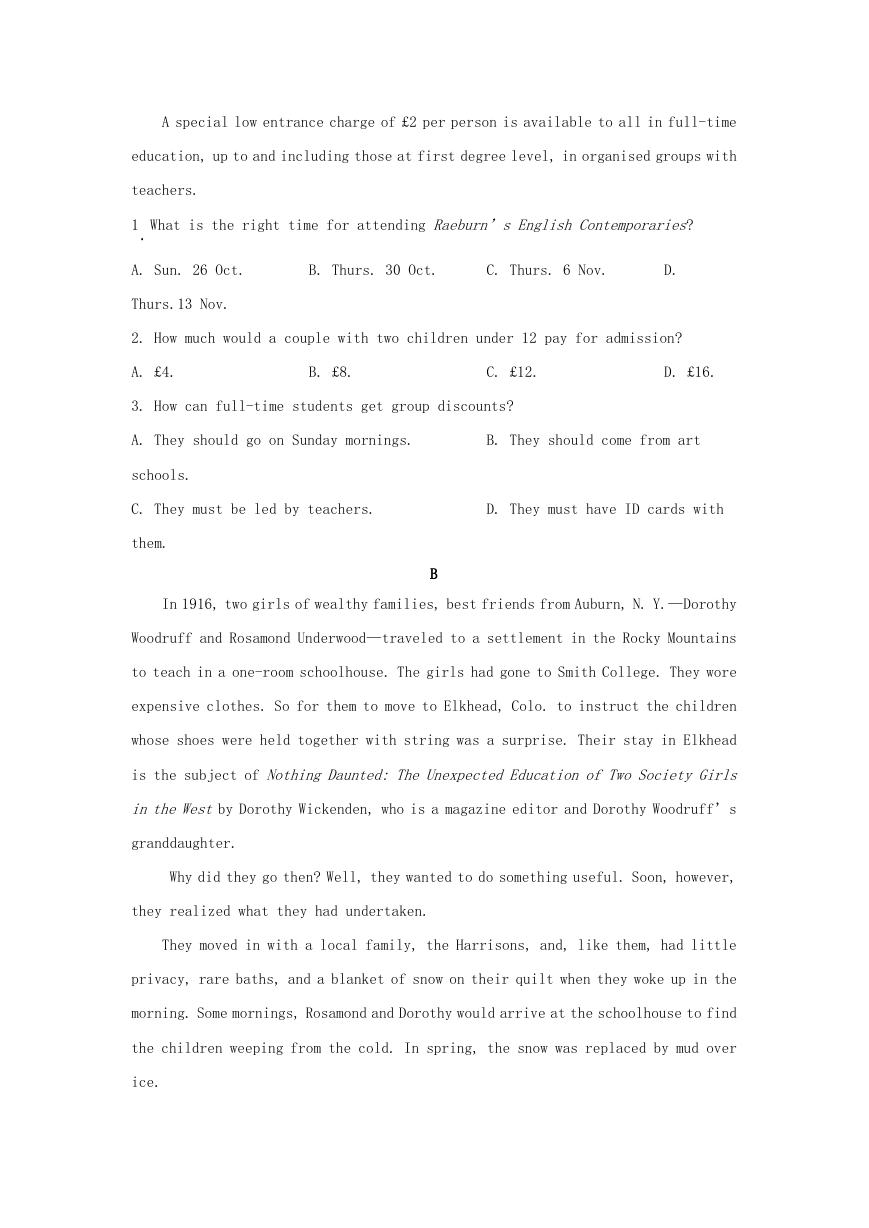
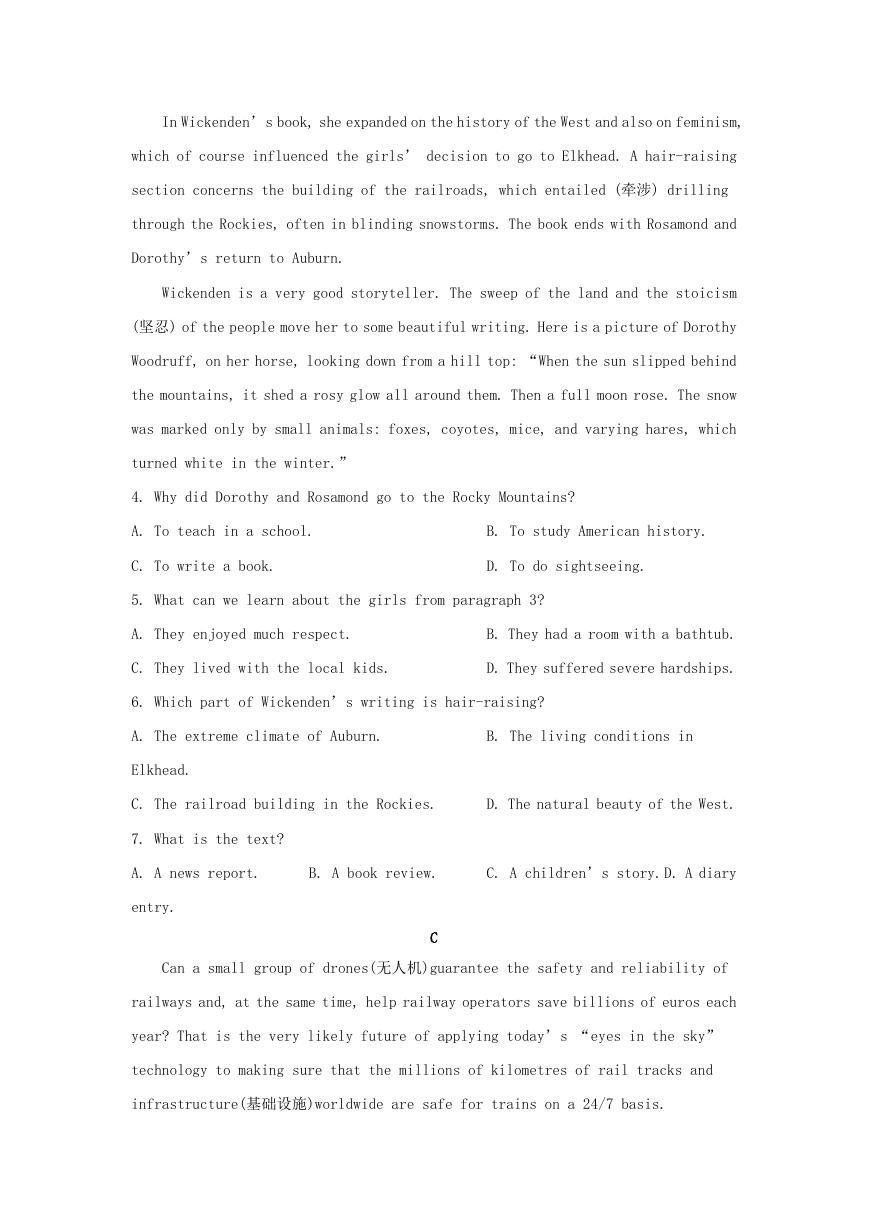
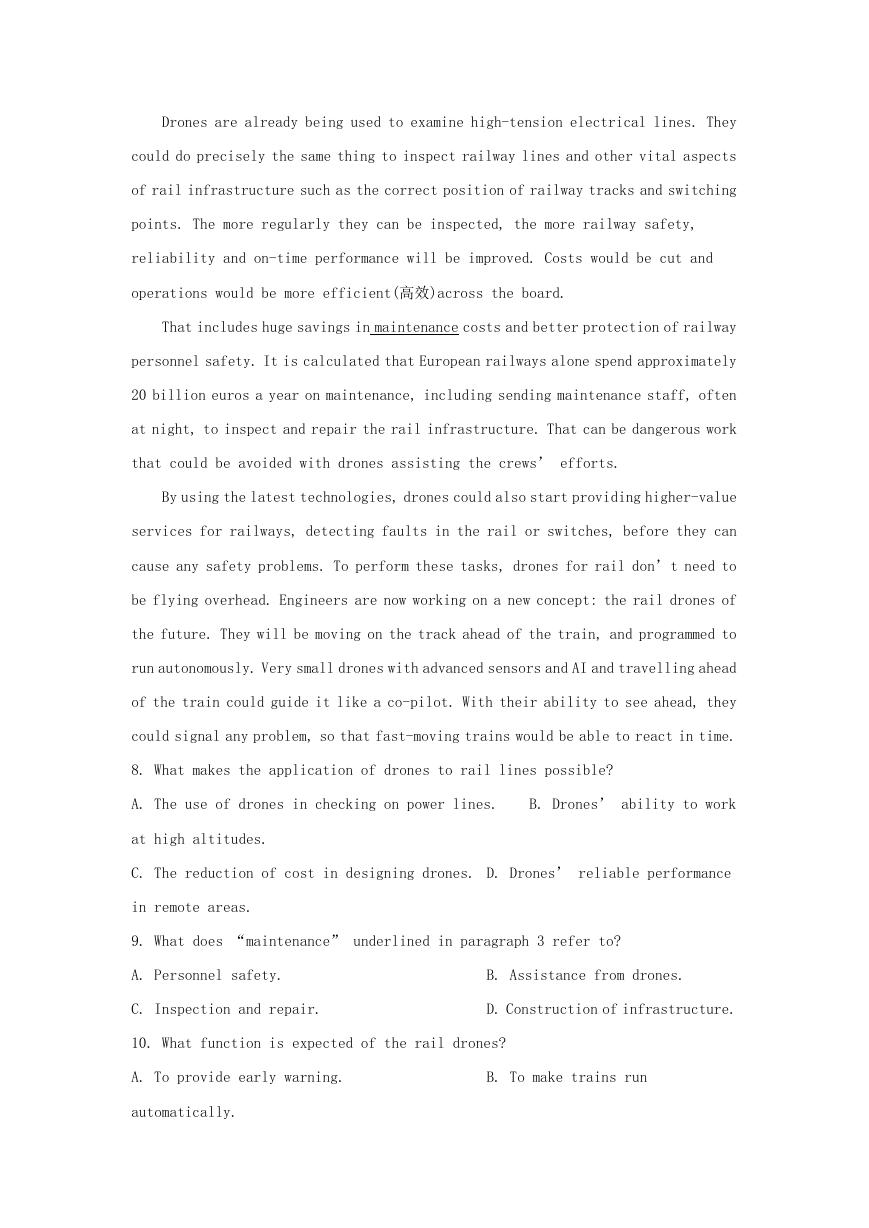
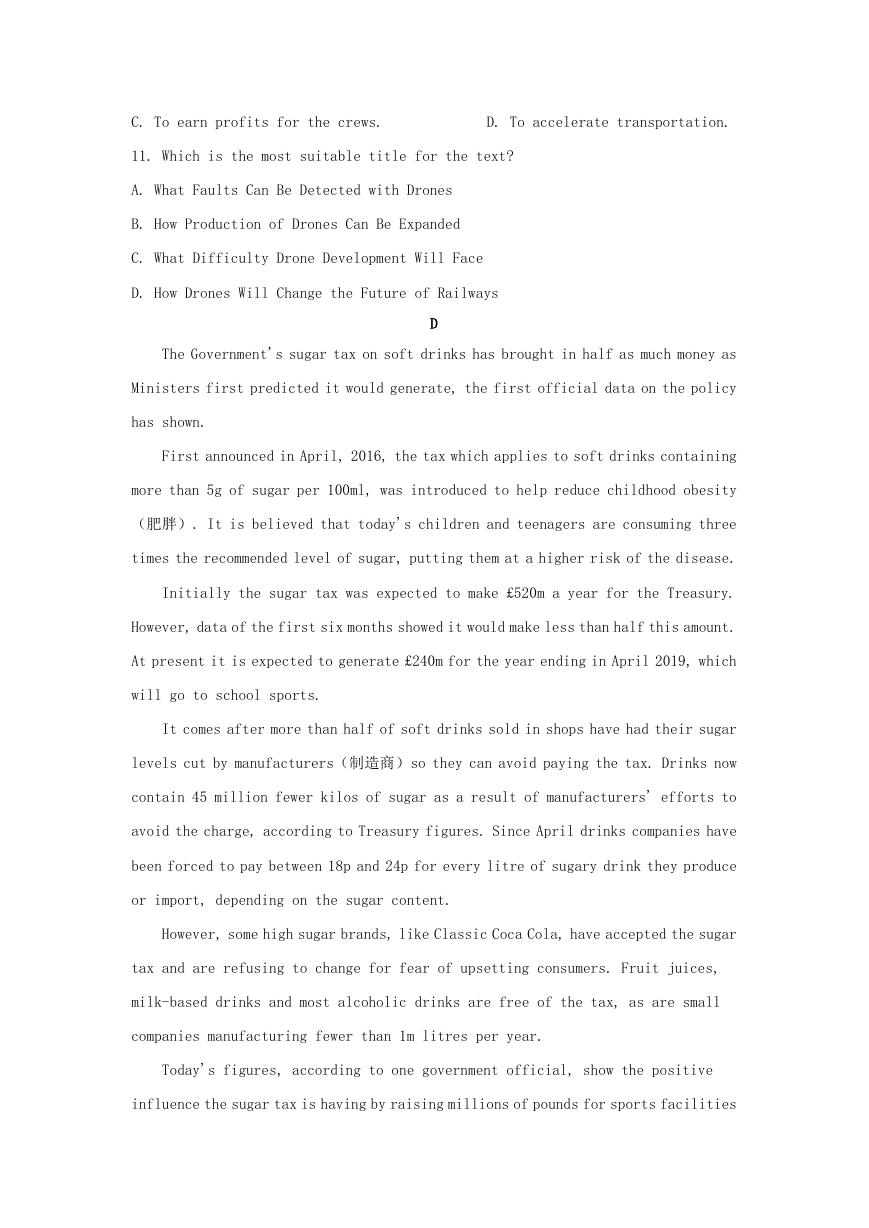
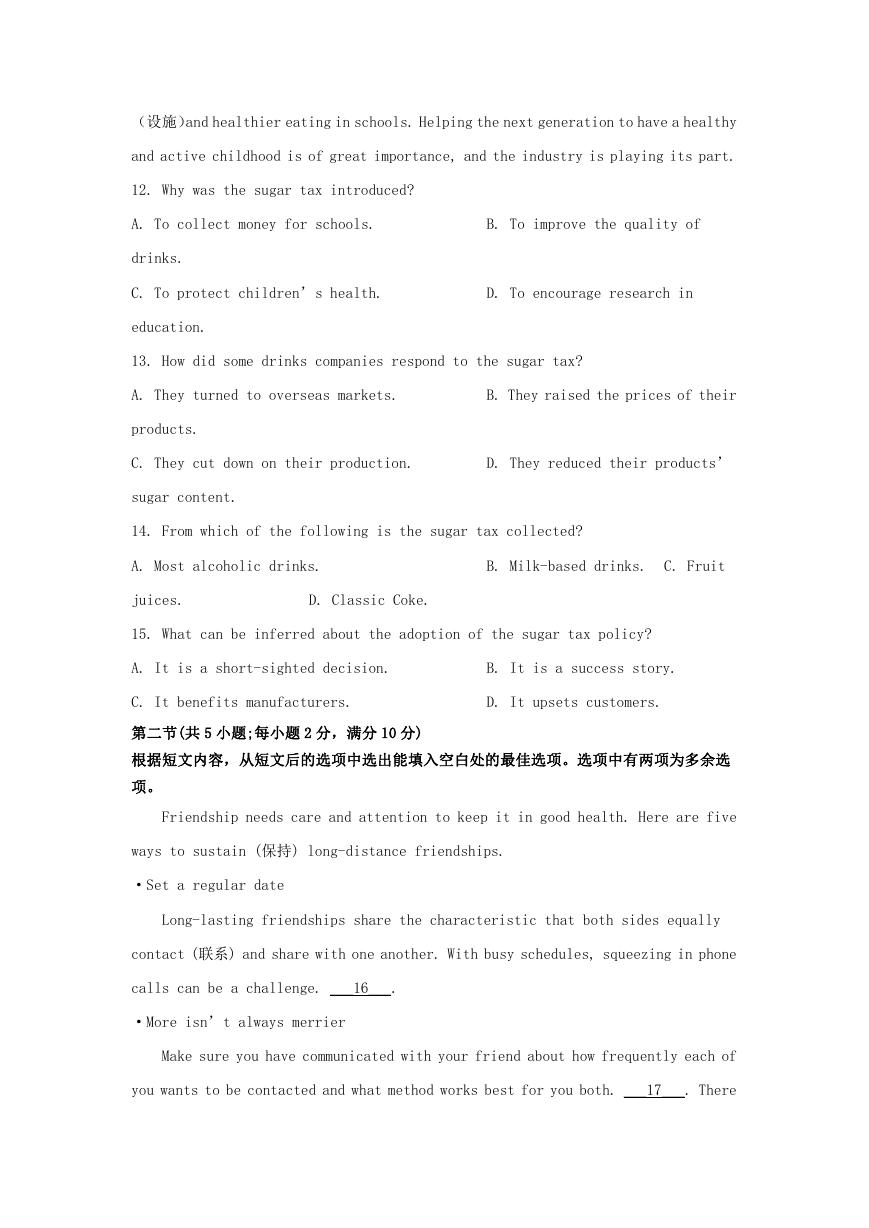








 2023年江西萍乡中考道德与法治真题及答案.doc
2023年江西萍乡中考道德与法治真题及答案.doc 2012年重庆南川中考生物真题及答案.doc
2012年重庆南川中考生物真题及答案.doc 2013年江西师范大学地理学综合及文艺理论基础考研真题.doc
2013年江西师范大学地理学综合及文艺理论基础考研真题.doc 2020年四川甘孜小升初语文真题及答案I卷.doc
2020年四川甘孜小升初语文真题及答案I卷.doc 2020年注册岩土工程师专业基础考试真题及答案.doc
2020年注册岩土工程师专业基础考试真题及答案.doc 2023-2024学年福建省厦门市九年级上学期数学月考试题及答案.doc
2023-2024学年福建省厦门市九年级上学期数学月考试题及答案.doc 2021-2022学年辽宁省沈阳市大东区九年级上学期语文期末试题及答案.doc
2021-2022学年辽宁省沈阳市大东区九年级上学期语文期末试题及答案.doc 2022-2023学年北京东城区初三第一学期物理期末试卷及答案.doc
2022-2023学年北京东城区初三第一学期物理期末试卷及答案.doc 2018上半年江西教师资格初中地理学科知识与教学能力真题及答案.doc
2018上半年江西教师资格初中地理学科知识与教学能力真题及答案.doc 2012年河北国家公务员申论考试真题及答案-省级.doc
2012年河北国家公务员申论考试真题及答案-省级.doc 2020-2021学年江苏省扬州市江都区邵樊片九年级上学期数学第一次质量检测试题及答案.doc
2020-2021学年江苏省扬州市江都区邵樊片九年级上学期数学第一次质量检测试题及答案.doc 2022下半年黑龙江教师资格证中学综合素质真题及答案.doc
2022下半年黑龙江教师资格证中学综合素质真题及答案.doc